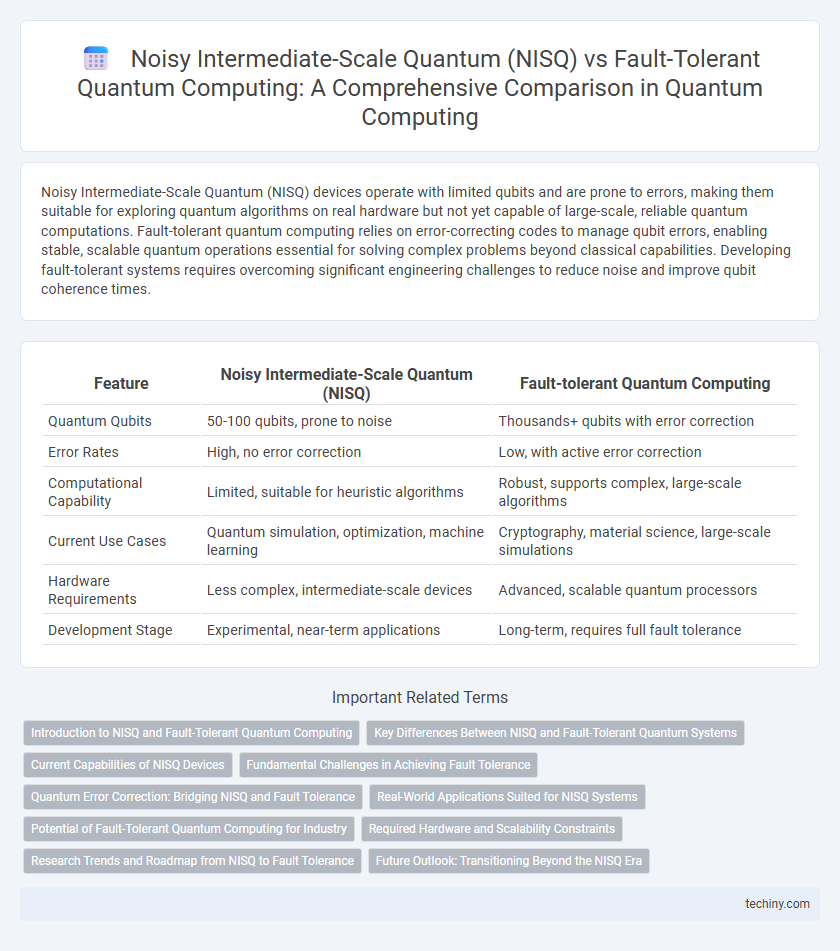Noisy Intermediate-Scale Quantum (NISQ) devices operate with limited qubits and are prone to errors, making them suitable for exploring quantum algorithms on real hardware but not yet capable of large-scale, reliable quantum computations. Fault-tolerant quantum computing relies on error-correcting codes to manage qubit errors, enabling stable, scalable quantum operations essential for solving complex problems beyond classical capabilities. Developing fault-tolerant systems requires overcoming significant engineering challenges to reduce noise and improve qubit coherence times.
Table of Comparison
| Feature | Noisy Intermediate-Scale Quantum (NISQ) | Fault-tolerant Quantum Computing |
|---|---|---|
| Quantum Qubits | 50-100 qubits, prone to noise | Thousands+ qubits with error correction |
| Error Rates | High, no error correction | Low, with active error correction |
| Computational Capability | Limited, suitable for heuristic algorithms | Robust, supports complex, large-scale algorithms |
| Current Use Cases | Quantum simulation, optimization, machine learning | Cryptography, material science, large-scale simulations |
| Hardware Requirements | Less complex, intermediate-scale devices | Advanced, scalable quantum processors |
| Development Stage | Experimental, near-term applications | Long-term, requires full fault tolerance |
Introduction to NISQ and Fault-Tolerant Quantum Computing
Noisy Intermediate-Scale Quantum (NISQ) devices encompass quantum processors with 50 to a few hundred qubits, operating without full error correction and thus susceptible to noise and decoherence. Fault-tolerant quantum computing relies on error-correcting codes and logical qubits to protect quantum information, enabling reliable computations at scale. The transition from NISQ to fault-tolerant systems is critical for achieving practical quantum advantage and scalable quantum algorithms.
Key Differences Between NISQ and Fault-Tolerant Quantum Systems
Noisy Intermediate-Scale Quantum (NISQ) systems operate with 50 to a few hundred qubits but lack full error correction, resulting in noise and limited coherence times that constrain algorithm complexity. Fault-tolerant quantum computing employs error-correcting codes across large qubit arrays, enabling stable operations and long coherence, which supports scalable, precise quantum algorithms. Key differences include qubit count, error correction capabilities, and readiness for practical, large-scale quantum applications.
Current Capabilities of NISQ Devices
Noisy Intermediate-Scale Quantum (NISQ) devices currently operate with 50 to a few hundred qubits, enabling experimental demonstrations of quantum algorithms despite inherent noise and limited coherence times. These devices excel at sampling problems and quantum simulation tasks but lack error correction, restricting their ability to perform deep circuits for large-scale computations. Ongoing research focuses on optimizing error mitigation techniques and hybrid quantum-classical algorithms to maximize the utility of NISQ hardware within its present limitations.
Fundamental Challenges in Achieving Fault Tolerance
Noisy Intermediate-Scale Quantum (NISQ) devices operate with limited qubit counts and error rates that hinder complex quantum computations, lacking robust error correction mechanisms. Fault-tolerant quantum computing aims to overcome these errors through implementing quantum error correction codes, requiring an exponential increase in physical qubits to encode logical qubits reliably. The fundamental challenges include managing error propagation, decoherence, and achieving scalable architectures capable of sustaining long coherence times for fault-tolerant operation.
Quantum Error Correction: Bridging NISQ and Fault Tolerance
Quantum Error Correction (QEC) is essential for advancing from Noisy Intermediate-Scale Quantum (NISQ) devices to fully Fault-tolerant Quantum Computing by mitigating qubit decoherence and operational errors. NISQ systems utilize limited error mitigation strategies, while fault-tolerant quantum computers employ robust QEC codes that enable logical qubits to outperform physical qubits in stability and fidelity. Developing scalable QEC protocols bridges the gap, allowing practical quantum algorithms to run reliably as hardware evolves towards fault tolerance.
Real-World Applications Suited for NISQ Systems
Noisy Intermediate-Scale Quantum (NISQ) systems excel in real-world applications involving quantum chemistry simulations, optimization problems, and machine learning tasks where error rates remain manageable. While fault-tolerant quantum computing promises scalable, high-precision operations through error correction codes, its practical deployment is still years away. Current NISQ devices enable near-term experimental advances in material science, drug discovery, and heuristic optimization by harnessing quantum parallelism despite intrinsic noise limitations.
Potential of Fault-Tolerant Quantum Computing for Industry
Fault-tolerant quantum computing offers scalable error correction mechanisms that enable reliable operation of quantum processors beyond the limitations of NISQ devices, making it crucial for addressing complex industrial challenges such as cryptography, optimization, and materials simulation. By overcoming decoherence and operational errors, fault-tolerant systems can sustain long computational sequences, unlocking new capabilities in pharmaceuticals, finance, and supply chain logistics. The transition to fault-tolerant quantum architectures thus promises transformative impacts on industry, driving innovation and efficiency with unprecedented computational power.
Required Hardware and Scalability Constraints
Noisy Intermediate-Scale Quantum (NISQ) devices operate with tens to low hundreds of qubits, relying on imperfect hardware that limits error rates and coherence times, imposing significant constraints on algorithm complexity and scalability. Fault-tolerant quantum computing demands robust quantum error correction, requiring thousands to millions of physical qubits to encode logical qubits, which necessitates advances in qubit fidelity, gate operations, and hardware architecture. The scalability of NISQ hardware is bounded by noise and decoherence, while fault-tolerant systems aim to overcome these limitations through redundancy and error mitigation at the cost of substantial hardware overhead.
Research Trends and Roadmap from NISQ to Fault Tolerance
Research trends in quantum computing emphasize advancing Noisy Intermediate-Scale Quantum (NISQ) devices by improving error mitigation techniques and quantum algorithm optimization to enhance computational reliability. The roadmap from NISQ to fault-tolerant quantum computing involves developing scalable quantum error correction codes, hardware coherence improvements, and logical qubit architectures capable of supporting robust, large-scale quantum operations. Progress in materials science, qubit connectivity, and hybrid quantum-classical frameworks is accelerating the transition toward fault-tolerant quantum systems.
Future Outlook: Transitioning Beyond the NISQ Era
The transition from Noisy Intermediate-Scale Quantum (NISQ) devices to fault-tolerant quantum computing hinges on breakthroughs in quantum error correction and qubit coherence times. Scalable quantum architectures with robust error thresholds are essential for realizing fault-tolerant systems capable of executing complex algorithms reliably. Advances in hardware stability, error mitigation techniques, and logical qubit encoding are shaping the roadmap toward practical, large-scale quantum computers beyond the NISQ era.
Noisy Intermediate-Scale Quantum (NISQ) vs Fault-tolerant Quantum Computing Infographic

 techiny.com
techiny.com